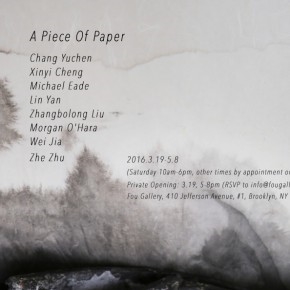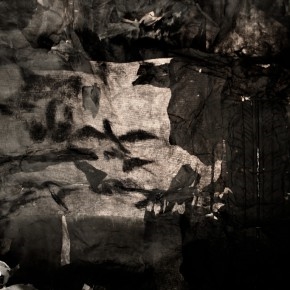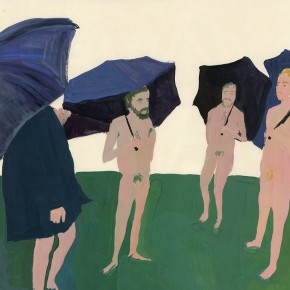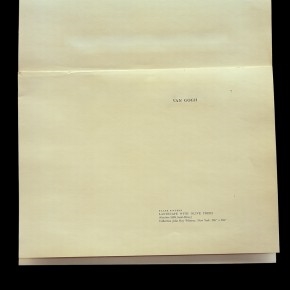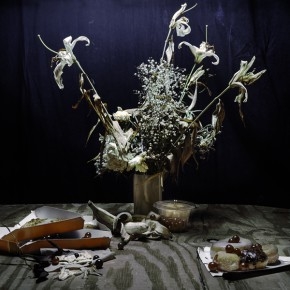
Traditional Chinese painting and calligraphy artists who work on handmade paper consider paper selection an indispensable part of their artistic creations. The pattern, texture and perviousness of the paper directly affect work’s presentation, and they sometimes even become part of the image. Japanese woodblock print artists in the 17th and 18th century first adopted Kozo paper, and they kept refining paper making techniques to present more elaborate Ukiyo-es. Western painters not only use works on paper as reference sketches for much larger paintings, but also value them as independent works. Compared to large-scale oil paintings, works on paper are more intimate and accessible, reflecting artists’ personal thoughts in the studio. Contemporary artists utilize paper in more diverse ways, often combining and rearranging it as media, material or source of inspiration. Fou Gallery is pleased to announce A Piece of Paper, a group exhibition of works on paper or inspired by paper, on view from March 19 to May 8, 2016. In this exhibition, works from eight artists with various culture backgrounds reveal the endless possibilities within a piece of paper.
In 2012, Chang Yuchen started her experimentations with various art forms and materials such as copper plate etching, sketch, mulberry paper, and accordion book. Her previous series Snake adopted different methods, and images of snake skin recorded the process of time and the damage of medium, resulting in ever-changing fine patterns. For this exhibition, she will present a thin and fragile installation of etching on Japanese paper. Floating patterns of heart, printed on a long scroll of Japanese paper, hang from the ceiling to the floor, which are continous with her explorations of printmaking and paper.
In Xinyi Cheng’s oil paintings and watercolors, images of hairy white man are repeated again and again to bring up her personal experiences and characteristics. Compared to the sentimental element and emphasis on color found in her paintings, her watercolors reflect a more abstract and freer spirit. Figures with various poses dissolve into dreamlike scenes, and viewers’ attention is drawn to these figures’ dilemma and existence when they examine the absurd story and orderless brushstrokes in her work.
Tree is a repeating metaphor in Michael Eade’s work. His prints reflect his on-going exploration of creating landscapes depicting real world places associated with mythologies referencing Eastern and Western art historical landscape formats. The two-block linocut, Sea Grape Branch, is inspired by watercolors and egg tempera studies that he created during residency at The Hermitage Artist Retreat (2010-2014) on the Gulf of Mexico, where the myth of the Fountain of Youth historically exists. For these delicate woodblock print works, the audience is invited to receive a dramatic and, even overwhelming viewing experience. An all-embracing pattern is hidden in his delicate depictions—those plant landscapes with various densities on handmade Japanese Misu paper, offering a familiar yet perplexing visual paradox.
Since 2005, Lin Yan started her practice of presenting eastern philosophy and immediate experience through ink and traditional handmade paper. In her works, Xuan paper is usually transformed into heavy, multi-layered forms, which fully reveal their personalities and rhythms with the help of lighting and space. At the same time, she also fabricates hard bricks and metal-like materials from Xuan paper. Patterns of plant fiber are condensed into natural and cultural images while peacefully mirroring struggles and vitalities in social unrests.
In his Traces series, started in 2012, Zhangbolong Liu attempts to document objects that have already disappeared completely from view, or, rather, his subject matter is to capture the “existence of non-existent things.” Within Liu’s photographs, time is seen to be the manipulating force over the traces left behind by removed objects. Through empty slideshow, missing objects in a museum showcase, leftover pinholes on isolated wallpaper and wrinkled bed sheets that have not yet been flattened out, the so-called “non-existent objects” are able to declare their existence after all. In this vast and ever changing universe, it seems as though fixed objects are, in fact, in a state of ceaseless transformation as well. The process of photographing their “traces” enables Liu to engage in the complex relationship between internal perception and external change, as well as documenting and affirming their existence.
For Morgan O’Hara, paper and pencil are both the recording media and the presentation subjects of her conceptual art. In her LIVE TRANSMISSION series from 1989 to present, intertwining yet lively pencil lines live transmit fluctuations and traces of life. Through her sharp, carefully controlled lines and orderly gestures, traces of various movements - whether by a passionate chef, a devoted shoemaker, or an elegant dancer - manifest O’Hara’s primordial nature and immediate concern for life.
Wei Jia has been pursuing an inseparable practice of combining personal memory and artistic creation. In his experimentation of seeking compatibility with ink and western art, he uses charcoal to copy calligraphy works in a random manner. Through repeated layering and re-tracing, a sense of distance and void gradually emerges from the translucent image. He also challenges and breaks the traditional technique and principles of calligraphy. By writing and dripping ink on Xuan paper before tearing them up and rearranging the images, Wei Jia tries to find a balance of threshold through eastern and western abstract elements.
Zhe Zhu started his Vanitas series in 2012. Inspired by “vanities,” a type of symbolic still life paintings that flourished in Flanders and the Netherlands in the 16th and 17th centuries. These paintings often use decaying flowers, rotten fruits, skulls, bubbles, clocks and other symbols to represent the meaninglessness of earthly life and the transient nature of all earthly goods and pursuits. For his work Fast Food, which will be shown in the exhibition, the artist gathers objects that are in different stages of consumption or decay, and arranges the photographic setting according to the aesthetics of vanities paintings. Greasy fast food wrapping papers juxtapose with decayed flowers and foods, presenting a mimesis of time while conveying personal moods in an era of consumerism.
About the exhibition
Opening Reception: Saturday, March 19, 2015, 4-6 pm. RSVP required
Hours: Saturday 2-6 pm, or by appointment
Artists: Chang Yuchen, Xinyi Cheng, Michael Eade, Lin Yan, Zhangbolong Liu, Morgan O’Hara, Wei Jia, Zhe Zhu
Courtesy of the artists and Fou Gallery.


